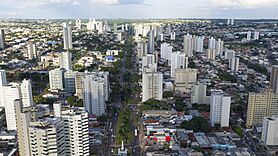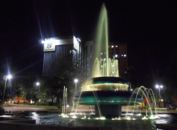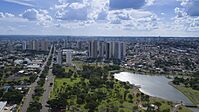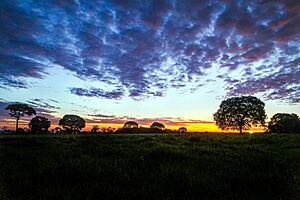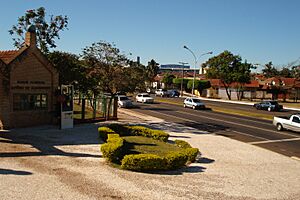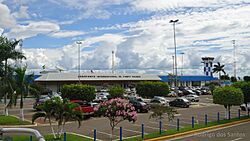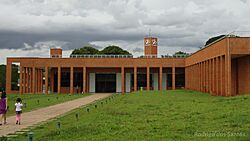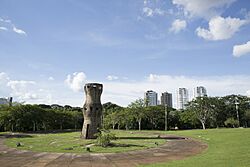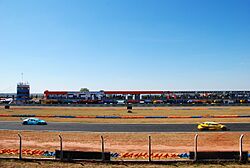Campo Grande facts for kids
Quick facts for kids
Campo Grande
|
|||
|---|---|---|---|
|
Municipality
|
|||
| Municipality of Campo Grande | |||
|
From the top, clockwise: city panorama with Afonso Pena Avenue highlighted; fountain at Praça Ary Coelho; Metropolitan Cathedral of Our Lady of the Abbey and St. Anthony; Morena TV tower; Indigenous Nations Park; Campo Grande Railway Station; Memorial of Indigenous Culture.
|
|||
|
|||
| Nicknames:
Cidade Morena (Portuguese for "Brown City"), CG, Campão (Big Field)
|
|||
| Motto(s):
"Poder, prosperidade e altruísmo" (Portuguese)
"Power, prosperity and altruism" |
|||
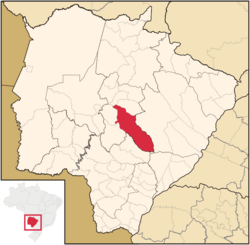
Location in Mato Grosso do Sul
|
|||
| Country | |||
| Region | Center-West | ||
| State | |||
| Founded | 1899 | ||
| Area | |||
| • Municipality | 8,096.05 km2 (3,125.90 sq mi) | ||
| • Urban | 154.5 km2 (59.7 sq mi) | ||
| Elevation | 592 m (1,942 ft) | ||
| Population
(2012)
|
|||
| • Municipality | 898,100 (17th) | ||
| • Density | 97.3/km2 (252/sq mi) | ||
| Time zone | UTC-4 (UTC-4) | ||
| • Summer (DST) | UTC-3 (UTC-3) | ||
| Postal Code |
79000-001 to 79129-999
|
||
| Area code | +55 67 | ||
| HDI (2010) | 0.784 – high | ||
Campo Grande means "Great Field" in Portuguese. It is a big city in the central-western part of Brazil. It is the capital city of the state of Mato Grosso do Sul. This city is known for its many trees and green spaces. In fact, most houses in Campo Grande have shade from trees!
Long ago, this area was a resting spot for travelers. They journeyed from places like São Paulo to northern Mato Grosso. In the early 1900s, a railway was built. This connected Campo Grande to Corumbá near the Bolivian border. It also linked to Bauru in São Paulo. Around the same time, the Brazilian Army set up a main base here. This made Campo Grande an important military spot.
The city has grown a lot. In 1970, about 140,000 people lived there. By 2008, this number grew to 750,000! Campo Grande is now one of the largest cities in Brazil. In 1977, the state of Mato Grosso was split. Campo Grande became the capital of the new state, Mato Grosso do Sul. It was already bigger than the old capital, Cuiabá.
Today, Campo Grande has a rich mix of cultures. Many people from different countries moved here. These include people from Japan, the Middle East, Armenia, Portugal, Germany, Italy, Spain, and Paraguay. Their cultures have blended with those of native Brazilian people. This includes Amerindian and Afro-Brazilian groups.
Contents
History of Campo Grande
Campo Grande began as a small village in 1877. It was founded by farmers José Antônio Pereira and Manoel Vieira de Sousa. They came from Minas Gerais after the Paraguayan War. They built their village, first called Santo Antônio de Campo Grande. It was near the Serra de Maracaju cliffs. Two streams, Prosa and Segredo, met there. Today, these streams follow two of the city's main avenues.
In late 1877, the first church was built. The first street, Rua Velha (Old Street), was formed by houses. Today, this street is called Rua 26 de Agosto. It ends at a square honoring immigrants.
The city grew quickly. Its good climate and location attracted many people. They came from other parts of Brazil. On August 26, 1899, the village officially became a municipality. It was then renamed Campo Grande.
Exploring Campo Grande's Geography
Vegetation and Nature
The area around Campo Grande has a type of tropical grassland. It is called "Cerrado". This landscape can be open grassland or have medium-sized trees. These trees grow over grass.
In the 1960s, large farms started to spread across the Cerrado. The state of Mato Grosso do Sul is now a big producer of soybeans.
Campo Grande also has two important nature parks. The Matas do Segredo State Park is 178 hectares big. It was created in 2000 to protect the Cerrado forest. The Prosa State Park is 135 hectares and was created in 2002.
Climate and Weather
Campo Grande has a tropical savanna climate. This means it has hot, humid summers. It also has a dry winter season. This dry season lasts from June to September.
The city gets about 1465 millimeters (57 inches) of rain each year. January is the warmest and rainiest month. Temperatures average around 29°C (84.2°F) during the day. Nights are about 20°C (68.0°F).
July is cooler but sunny. Daytime temperatures average 25°C (77.0°F). Nights can get down to 14°C (57.2°F). Sometimes, in winter, temperatures can drop close to freezing. Heavy rains can cause floods in the city.
Economy and Jobs
Most people in Campo Grande work in shops and services. But farming and related businesses are also very important. Raising livestock (like cows) is a big part of the economy. The meat is sold in Brazil and other countries.
Besides food processing, building and making things from minerals are also key industries. Important crops grown here include soy, rice, and manioc. Recently, sugar cane has also become important.
In 2013, the city's total economic output (GDP) was about R$20.7 billion. This made it the richest city in its state. It was also the third richest in the Central-West region of Brazil.
Education and Learning
Portuguese is the main language taught in schools. But students also learn English and Spanish in high school.
Universities and Colleges
Campo Grande has several universities for higher education:
- Universidade Federal de Mato Grosso do Sul (UFMS) – This is a federal university.
- Universidade Estadual de Mato Grosso do Sul (UEMS) – This is a state university.
- Universidade Católica Dom Bosco (UCDB) – This is a Catholic university.
- Faculdade Campo Grande (FCG) – A local college.
- Centro Universitário de Campo Grande (UNAES) – An academic center.
- Universidade para Desenvolvimento do Estado e da Regiao do Pantanal (UNIDERP) – Another academic center.
Transportation Around the City
International Airport
Campo Grande International Airport handles flights. It shares its operations with the Campo Grande Air Force Base. The airport has two runways.
Medium-sized planes like the Boeing 737 can land here. Sometimes, even larger planes use the airport. Most flights are within Brazil. There are also some flights to Bolivia and Paraguay.
The Campo Grande Air Force Base - ALA5 is also located here. It is one of the most important bases for the Brazilian Air Force.
Railroad System
Campo Grande has a railway system. It is managed by the Novoeste company. This railway connects Campo Grande to other cities. It goes from Bauru in São Paulo state to Corumbá and into Bolivia. This helps move products to other areas. Currently, only freight trains use this railway. There are no passenger services.
Highways for Travel
Three main federal highways meet in Campo Grande.
- BR-262 connects Campo Grande to Corumbá and Bolivia in the west. It also links to the Brazilian state of São Paulo in the east.
- BR-163 connects Campo Grande to Cuiabá and the Amazon region in the north. To the south, it goes to Dourados, which is close to the Paraguayan border.
- BR-060 links Campo Grande to the state of Goiás and the capital city of Brasília in the northeast.
Several state highways also connect to Campo Grande.
Culture and Traditions
Festas Juninas are popular celebrations. They were brought to Brazil by the Portuguese. These parties are also celebrated in Campo Grande. People enjoy special foods, decorations, and music. There are also dances, bonfires, and fireworks.
The Campo Grande Film Festival happens every year. It takes place in January and February. It started in 2004. The festival shows independent movies. These include Brazilian and foreign films. It also features regional and short films.
Sports and Activities
Car Racing Fun
The city has tracks for car and kart racing. The Orlando Moura International Autodrome is 3,433 meters (11,263 feet) long. The Kartódromo Ayrton Senna track is 930 meters (3,051 feet) long.
Football (Soccer)
Like everywhere in Brazil, football is the most popular sport. Campo Grande has a big football stadium. It is called Estádio Universitário Pedro Pedrossian. People often call it "Morenão". This means "the big brown" in Portuguese. The stadium opened in 1971 and can hold up to 45,000 people.
There are five other smaller stadiums in the city. They sometimes host games. The city's main football teams are Esporte Clube Comercial and Operário Futebol Clube.
The city also has 45 multi-sport fields. These are found in clubs, cultural groups, and public squares.
Volta das Nações Marathon
"Volta das Nações" is a half-marathon race. It is 21 kilometers long. This race takes place at Parque das Nações Indígenas every October. About 26,400 people join the race. This includes professional athletes from Kenya and other countries.
Notable People from Campo Grande
- Rafael Silva, a judo athlete
- Leonardo de Deus, a swimmer
- Müller, a football player
- Hoover Orsi (born 1978), a racing car driver
Sister Cities Around the World
Campo Grande is connected with other cities around the world. These are called "sister cities".
See also
 In Spanish: Campo Grande (Mato Grosso del Sur) para niños
In Spanish: Campo Grande (Mato Grosso del Sur) para niños


